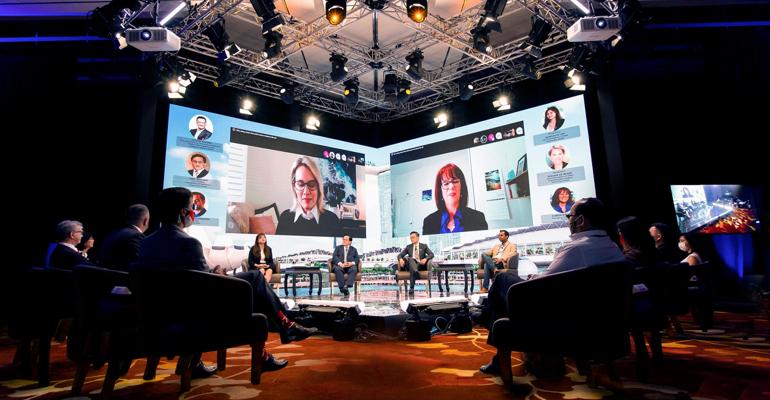Here’s a fun exercise. In your mind, go back to early 2020 and imagine that your organization’s leaders told you this:
An event you’ll be working on at the end of this year will involve multiple in-person meeting sites along with a virtual audience across several time zones; a combination of prerecorded content and live presentations, with a few delivered from remote locations; and some collaboration between the in-person and remote audiences but also separate networking opportunities for each audience.
You probably would have laughed and said, “Um, sure. I’ll get into my time machine and make all that happen.”
Fast forward one year, however, and events like that are actually happening. Thanks to the Covid-19 pandemic, the meeting industry has seen roughly five years of technological progress compressed into the past 12 months, according to several event-tech suppliers.
The good news is that most hybrid meetings do not require the degree of sophistication as the example above. In fact, a hybrid event could involve simply having the session leaders and a small audience gathered in a presentation studio to deliver to a mostly virtual audience. Or if the in-person experience is critical to the event, the presentation studio can act as a hub with in-person sites in other cities, commonly referred to as “viewing parties,” as the spokes.
At the moment, in-person gatherings for these “hub-and spoke” hybrid events range from 25 to 250 attendees, depending on a destination’s Covid-safety regulations and social-distancing requirements. But in the future, there could be a lot more people gathering in person at multiple sites for a single event. Each live group and those attending virtually can experience the same content. However, between sessions, face-to-face networking and collaboration can be the focus. In fact, as networking features on virtual-event platforms become more robust, online attendees now have better opportunities to make meaningful connections—a benefit that used to be the exclusive domain of in-person meetings.
As for the virtual and in-person audiences mingling seamlessly, that is a tougher task. While real-time polling and Q&A functionality can unite an audience to some degree during a live keynote or breakout, there’s little else outside of chat feeds right now to make real-time interactions between virtual and in-person participants simple.
Two Meetings in One
The move to a hybrid-meeting format means more work for planning teams. “When you get away from having just one audience and using one medium, you have to take a distinctly different approach,” says Richard Stewart, managing director, North America, for experiential event agency VOK DAMS. “Each attendee segment is getting something different from the meeting, so you have to project-manage this thing differently.”
Several months ago, his firm helped cosmetics giant L’Oreal create a two-day hybrid event from the firm’s New York office. There was a small in-person audience in front of the presenting executives, but also attendees watching a video feed beamed to gathering areas within that same building as well as a virtual audience around the country. In between real-time speakers and panels, there were prerecorded video segments.
When building a hybrid-meeting agenda, “if you make the experience too physically oriented, then you dilute the virtual attendees’ experience. Conversely, if you make it too virtually oriented, you will dilute the physical experience,” says James Frankis, director of product for Convene, which operates day-meeting spaces with production and broadcast capabilities in several U.S cities and London.
Shayna Moskowitz, DES, director of meeting and event technology for Part 2 Events, stresses that a hybrid event “can’t just be a livestream of eight hours of sessions from an in-person event; remote attendees would never sit through that. The mindset for creating an engaging experience has to change, especially for fully virtual attendees.”
To satisfy all audiences for a meeting, Frankis believes that planners should create two distinct experiences, an in-person and a remote, where the same content is not always presented to both audiences. In such cases, “the key is to build in a few ‘peak moments’ that are simultaneous for both,” such as keynote presentations and critical breakout sessions—opportunities for the two audiences to come together through real-time surveying that guides the direction of a session or a Q&A session with high-profile presenters. Then “with other breakouts as well as the networking opportunities and sponsor engagement, it’s probably better to run those things separately; the in-person and remote versions don’t even have to happen on the same day.”
Taya Paige, engagement strategies advisor for ITA Group, which executes many pharmaceutical and medical-device industry events, advises that “whenever you can, record sessions prior to presenting them to the virtual audience; that almost always works out better and you could still conduct a live Q&A with the presenter when you broadcast. Also consider all the time zones your attendees are in so you can stagger your content delivery for maximum reach.”
Part 2: Hybrid Meetings: Prepping Speakers, Evaluating Tech Platforms





